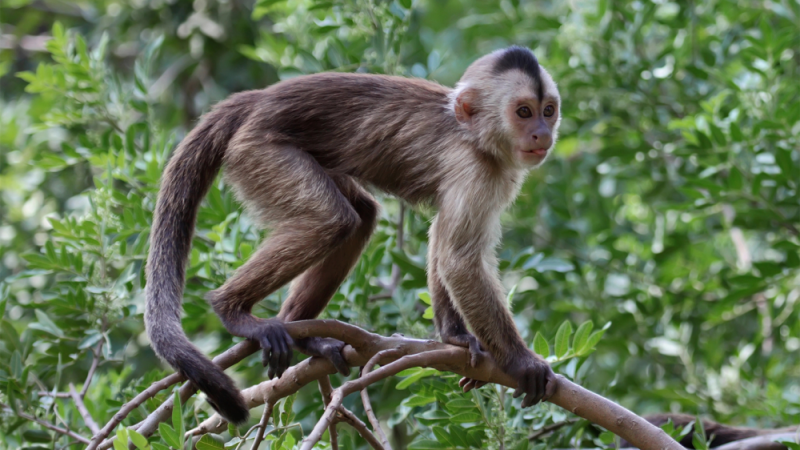Why we don’t have tails

It has been an enduring evolutionary mystery since the days of Charles Darwin: When did humans lose their tails? Apes–including humans and chimpanzees–are all primates who do not have long tails like lemurs and our other monkey relatives. Thanks to some advances in gene-editing technology, a new clue to ape tail loss has been uncovered. A genetic diversion in our ancient ancestors about 25 million years ago, according to a study published February 28 in the journal Nature.
[Related: Our tree-climbing ancestors evolved our abilities to throw far and reach high.]
Apes vs. monkeys
Tail loss in apes began as the group evolved away from Old World monkeys between 20 and 25 million years ago. After this evolutionary split, apes evolved the formation of fewer tail vertebrae. This formed our coccyx–or tailbone.
While the reason why apes lost their tails in the first place is uncertain, some scientists not having a tail may have been better suited for vertical bodies living on the ground. Tailed primates generally use these appendages to help them swing from tree branches and walk on along them horizontally. Gibbons and orangutans are tailless apes that still live in trees, but they move differently than monkeys who have tails and hang below branches.
Previous studies have linked over 100 genes to the development of tails in vertebrates, so the general belief has been that tail loss occurred through changes in DNA’s code–or mutations–on more than one gene.
Jumping genes
In the new study, a team of researchers compared the DNA of six species of apes–including humans–and 15 species of monkeys. They found an insertion of DNA that is shared by apes and humans, but is not present in monkeys. It is located on a gene called TBXT, which is known to affect animal tail length.
Once they pinpointed this mutation, they used CRISPR to edit the same spot on the gene of mouse embryos in a lab. The mice with the altered TBXT genes were born with a variety of tail effects, including some that were born without tails at all.
Interestingly, the differences in tail outcomes didn’t just result from the mutations to TBXT genes. DNA is in a twisted-ladder or double-helix of bundles of different genes with various functions. DNA allows animals to evolve with changes to genes, but some of the changes only occur on a single rung of DNA’s twisted ladder. Other changes are more complicated and happen on multiple rungs. These Alu elements are repetitive DNA sequences that can create bits of RNA that can then change back to DNA. Once they’ve switched back to DNA, they randomly insert themselves into the genome. These types of “jumping genes” can then disrupt or enhance a gene’s function when it is inserted.
[Related: A scientific exploration of big juicy butts.]
The team found two Alu elements in the TBXT gene that are present in great apes, but not in monkeys. These jumping genes exist only in primates and have been behind this genetic diversion for millions of years.
Genetic trade-off?
According to the team, any advantage of tail loss must have been very powerful. Genes can often influence more than one bodily function, changes that bring an advantage in one area may prove detrimental somewhere else. The team did find a small increase in neural tube defects in the mice they had inserted with the TBXT gene.
Future studies could test the theory that an ancient evolutionary genetic trade-off of losing a tail contributed to neural tube birth defects. These defects include spina bifida, which is seen in roughly one in 1,000 human babies.










